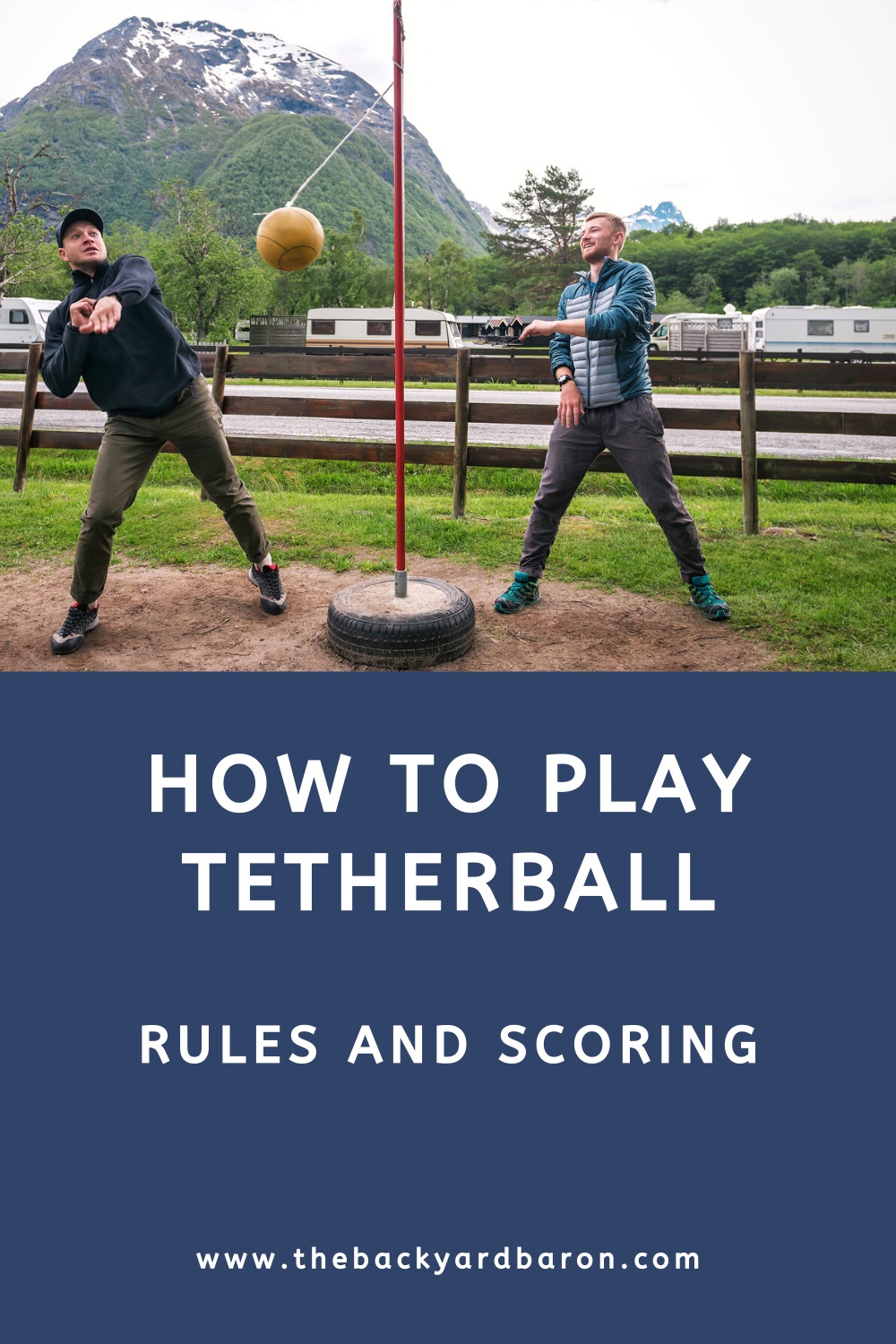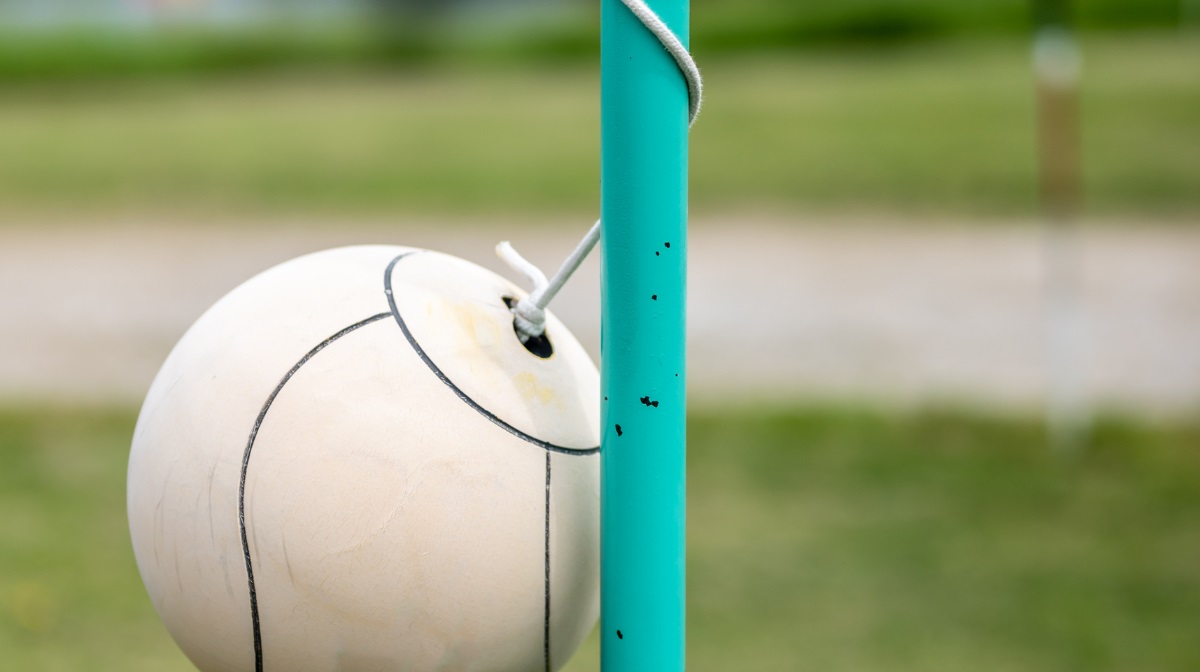I may earn a small commission from purchases made through product links on this website at no extra cost to you. As an Amazon Associate I earn from qualifying purchases.
Last updated: February 29, 2024
Learn how to play tetherball with this guide for beginners, explaining the rules, the setup, and the scoring system of this outdoor game.
Tetherball is a fun and easy-to-play game that requires only a few pieces of equipment and very little space. The basic principle of the game is to strike a ball on a string around a pole.
The game is typically played by two people, but you can also practice alone. Tetherball is not just a fun game; it’s also a great way to get some decent exercise in.
In this article, you will learn how to play tetherball, as I will talk you through the rules, the scoring, the setup, and the equipment needed.
What Is Tetherball?
Believe it or not, tetherball has actually been around for quite some time.
History
Some theories suggest that the earliest concepts for tetherball developed from the classic maypole in old festivals.
When you look at the traditional dances around the maypole, you can certainly see how this might have evolved into today’s game of tetherball.
According to this article, tetherball started in Great Britain in 1875. The first official rules for the game dictated the use of a tennis ball and tennis rackets, which some referred to as tether tennis.
The game quickly grew in popularity, and by the 1920s, a tetherball pole was often seen in schoolyards.
While you can still play tetherball with a tennis ball and rackets, the ball now mainly used resembles a volleyball. This type of ball lends itself well to hitting with the hand.
Even though tetherball is widely played, there appears to be no central rules body for the game. You can find different game variations everywhere, and you can pick and choose the rules you find most suitable.
Why do I like this game?
I enjoy this game, not just because it’s fun but also because it’s an effective way of exercising. I’m not much of a runner, and playing tetherball for a few hours is much more fun.
It’s also a game that you can get better at with more practice. I’m a pretty competitive person, and tetherball offers a good balance between fun and competitiveness.
- TETHERBALL SET: Take fun back to days on the playground and school recess with...
- CLASSIC FUN: Encourage the whole family to get active outdoors with fun and...
- INSTANT SETUP: Simply stake the bottom into grass or sand and connect the poles...
Tetherball Rules for Dummies
To explain the game of tetherball, I am going to walk you through the following topics:
- Equipment
- Court Setup
- Game Rules
- Fouls and Penalties
- Strategies
Let’s first quickly talk about the equipment required to play tetherball.
1. Equipment
To play tetherball, you will need three pieces of equipment:
- Pole
- Rope
- Ball
The game is played around the free-standing pole in the center of a circle. The pole should be around 10 feet high, but you can change this based on the player’s height. The pole can have a diameter of 2 to 4 inches.
The pole can either be stuck into the ground (patch of grass), or a weighted base can be used to hold the pole in place. If you’re going to stick the pole into the ground, try to go for about two feet of the pole in the ground. You could even create a permanent tetherball pole by literally cementing the pole into the ground.

The string or rope is usually about 8 feet long and is attached to the pole at the top. Any type of rope can be used, but it should be flexible and not too thick. The ball should ideally hang at least two inches off the ground.
Finally, there’s the tetherball, which typically looks like a volleyball. You can use any ball as long as it’s easy enough to hit it with your hands. The ball, of course, needs to be attached to the rope.
Rather than going DIY, you could also buy a tetherball set from Amazon. They’re easy to set up, and you can start playing right away.
2. Court Setup
A tetherball court can be set up in two ways:
- Four zones
- Two zones
First, create a circle with a diameter of around 20 feet. This is not set in stone, but it is a good size.
To create a court with four zones, draw an X where the center of the X is the pole. If the circle is a clock, draw one line from 11 to 5 o’clock, and another from 1 to 7 o’clock.
Two bigger zones will be the playing zones, where the players can make their hits. The other two zones are the neutral zones (or out-of-bounds zones, foul zones), where players cannot enter during play.
Here is a tetherball diagram:

A court set up with two zones is much easier and keeps the game simpler. The court is still a circle but only contains two zones, one zone for each player.
To make it even simpler, don’t worry about zones at all. Two players start on opposite sides and can start playing from there and move around freely. This basic setup is best for kids who just want to have a bit of fun.
If you’d like to learn more about setting up a tetherball game, check out my tetherball court dimensions article with a full breakdown of what the court and the pole should look like.
3. Game Rules
The rules for tetherball are quite straightforward.
Players decide who will start serving. After the first game, the winner gets to keep the serve. The player that starts serving, strikes the ball in the direction they choose or otherwise mutually agree upon.
The receiving player returns the ball and can only do so from within their zone. If you miss the ball, you can try to hit it back when it re-enters your zone. When your opponent misses, you can hit the ball again to increase its speed when it comes back to your zone.

The idea is to strike the ball such that the rope wraps around the pole. Once the entire rope is wrapped around the pole and the ball can’t be hit anymore by your opponent, you win that round.
If you are going to play alone, the aim is to keep the serve going. Each time it enters your zone, you have to hit the ball in the opposite direction. You can time yourself to see if you are improving.
Scoring System
As mentioned, the aim is to get the ball stuck by having the rope wrapped around the pole. That goal is achieved when the ball stops spinning around the pole or snaps back and changes direction.
A point is scored when a player manages to get the rope fully wrapped around the pole unless they commit a foul. You can set the number of points before each match; for example, 21 for a long match, or a best-of-9 for a quicker match.
If there are multiple players, the loser leaves the court, and the winner can challenge the next player. The winner can keep serving.
4. Fouls and Penalties
There are a few ways you can commit a foul and receive a penalty while playing tetherball.
Here are some examples:
- Hitting the ball outside of their zone.
- Using any part of their body besides their hand to strike the ball.
- Touching the pole.
- Touching the rope.
- Holding or catching the ball to stop play.
When someone commits a foul, you can not allow them to hit the ball the next time it is in their zone, or they can be disqualified and automatically lose a point.
5. Strategies
Tetherball is a pretty straightforward game, but more experienced players can apply techniques and strategies to surprise their opponents.
One way to do so is by suddenly varying the speed and angle of your hits. Constantly hitting the ball as hard as you can may become predictable.

You can hit the ball with either hand. Sometimes you can make it look like you’re coming in from one angle, and then you change the hit with your off-hand at the last moment.
Another thing you can try is hitting the ball toward your opponent instead of going wide, which can make their attempt to return the ball more challenging, or they may even go out of their zone.
Final Thoughts
As easy as the tetherball rules are, you do need good skills to get better at this exciting game. The best thing you can do is simply get started to see whether you’re going to enjoy playing tetherball.
Buy a tetherball set online that is easy to set up, and if you do enjoy playing, you can always try to create a permanent tetherball court in the corner of the backyard.
Here are some more sports and games to play in the yard:


